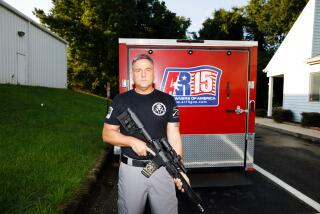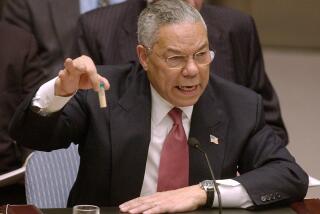Untangling the Threads of Iraq’s Arms Network : Military: The U.S., Britain and other Gulf War allies played roles in piecing together Baghdad’s weaponry.
- Share via
LONDON — Saddam Hussein’s most-prized weapon lay concealed on a mountaintop in northern Iraq, where it was not discovered until well after the Persian Gulf War. The 165-foot-long cannon, capable of firing projectiles armed with nuclear devices and lethal chemicals at targets more than 100 miles away, had been tested and was nearly operational.
The cannon was one of several “super-guns” that Hussein planned to acquire as part of his ill-fated drive toward military dominance in the Persian Gulf. The shrouded path it traveled on its way to Iraq can now be traced through five Western nations and represents the clearest evidence yet of Hussein’s ability to exploit foreign governments to further his objectives.
The high-strength steel for the gun’s massive barrel came from a company owned by the British government. Machinery to produce its projectiles came from Matrix Churchill, a British company with a subsidiary in Ohio. Computers and software to refine the ballistics to within a ten-thousandth of an inch were sold with approval of the Bush Administration to a Belgium firm doing the overall design. The loading mechanism was manufactured in Switzerland. Financing was provided by the Atlanta branch of Italy’s Banca Nazionale del Lavoro.
The cannon was one of at least two super-guns that were actually built and test-fired before Hussein’s war machine was crushed in Operation Desert Storm. A second prototype of similar size remains hidden in Iraq, according to one of its designers, and a far more fearsome, 500-foot-long version was on the drawing boards.
The super-guns were part of a $20-billion Iraqi arsenal acquired from the West by a military supply network whose inner workings are only now unraveling through documents and interviews here and in Washington.
As new details emerge in what has become an expanding political scandal for Prime Minister John Major, it is becoming clear that the United States and Britain--the two major Desert Storm allies--also played major roles in building up the Iraqi forces they ultimately confronted on the battlefield. Indeed, there are striking similarities between the prewar policies of the two countries and their responses to disclosures of those policies.
Faced with almost daily attacks in Parliament and the press, Major has adopted the same defense used in recent months by President Bush. He has sought to minimize the significance of the British exports to Iraq and maintained that nobody told him about violations of the arms embargo.
The scandal, referred to here as Iraqgate, exploded two weeks ago when the government was forced to dismiss charges against three former Matrix Churchill executives accused of breaking the law by selling machine tools to Iraq. The case collapsed after a former Cabinet minister admitted that he had encouraged the sales.
Evidence showed that the government appeared willing to jail the businessmen to protect the secret policy. Responding to the resulting political outcry, Major created an independent judicial inquiry to examine whether 30 British companies were given a wink and a nod as they sold sensitive goods to Baghdad. By week’s end, Scotland Yard also was investigating the former Cabinet minister, whose earlier statements to authorities had not mentioned his encouragement to the companies.
Government actions here mirror those in the United States, where a special Justice Department investigator is expected to report by Dec. 8 on whether policy considerations interfered with prosecution of the former manager of the BNL branch bank in Atlanta.
The controversies on both sides of the Atlantic reflect the willingness of the United States and Britain--as well as such countries as Germany, France, Italy and Switzerland--to tolerate and, in some cases, encourage Iraq’s military acquisitions despite public avowals of neutrality.
The supply network that flourished in this fertile soil was as sophisticated as any in history, using front companies and agents spread across the globe.
A secret British government analysis prepared in early 1990 provides a blueprint of how the Iraqis operated, and how British firms assisted them. The report cited a German government official’s description of Libya’s construction of a chemical plant in the late 1980s by using different contractors in different countries to obtain various components of the plant. “This meant that it was difficult to get an overview of the work and its extent until the plant was almost complete,” the German told European defense officials.
The analysis said the British Ministry of Defence “believes that a similar situation is building up regarding the amount of assistance that ‘UK Ltd.,’ and in particular our machinery manufacturers, are giving to Iraq toward the setting up of a major arms R&D; and production industry.”
The Iraqis had been operating just that way for years, and on a far larger scale than Libya. Components for weapons, even entire arms factories, were acquired from suppliers in different parts of the world and shipped separately to Iraq for assembly. British intelligence had known about key elements of the network since at least 1987, and U.S. intelligence had known for almost as long.
In May, 1987, an overweight agent for Britain’s MI5 domestic security service using the name Michael Ford began a series of clandestine meetings with Mark Guttridge, a salesman for Matrix Churchill, a company in Coventry that produced computer-operated machine tools. The firm was doing some business with Iraq.
Within six months, Guttridge became a golden source. Operating through a front company called TDG, Iraq bought control of Matrix Churchill and began a torrent of sales to Baghdad. An internal Matrix computer printout shows 55 sales to Iraq between 1987 and 1990.
Ford’s written reports to MI5 show that Guttridge provided a running description of Iraq’s efforts to build its own arms factories using Matrix tools, and of more ambitious attempts to obtain technology for nuclear and chemical weapons.
Among its many uses, Matrix machinery was integral in extending the range of Iraq’s Scud missiles and in developing advanced 155- and 210-millimeter howitzers. These self-propelled guns were created for Iraq by Gerald Bull, a Canadian-born scientist regarded as the world’s greatest artillery designer.
According to records and interviews with former employees of Bull’s Space Research Corp., Bull began working for Iraq in March, 1988. While the howitzers were the priority, a bonus for the Iraqis was Bull’s simultaneous work on another project: the super-gun.
In 1980, Bull spent six months in prison for violating U.S. export laws in connection with the sale of $30 million worth of arms to South Africa. He had since moved his operations to Britain and Belgium. But, according to two former Bull employees, the company still did not want to run afoul of the U.S. government.
As work began on the howitzers, Bull’s son Michel and another company officer went to Washington in March of 1988 and met with a State Department official, according to the sources. They reportedly explained the work for Iraq and received an informal assurance that they could proceed.
Asked about these accounts, a State Department spokesman acknowledged that such a meeting took place but said the department official who met with Bull and the other executives had no recollection of Iraq being mentioned.
Throughout 1988 and into 1989, about 30 of Bull’s engineers and technicians worked in Iraq while the design of the super-gun took place in Belgium.
Christopher Cowley, a British engineer with a doctorate in metallurgy, was Bull’s project manager for the super-gun. He spent many weeks in Iraq in 1988 and 1989.
In hours of interviews at his home near Bristol recently, Cowley described how plans for 500,000 rounds of ammunition for the howitzers and for projectiles for the super-gun were provided to Matrix Churchill so the firm could design the machinery to produce the components. Among the drawings were overall designs for the super-gun, which Cowley said were provided to British intelligence by Paul Henderson, the managing director of Matrix.
“Of course I knew the drawings were going right to British intelligence,” said Cowley. “We weren’t worried because we knew the government had approved the project.”
The full-scale super-gun, which was never built, was to be like no other weapon. The barrel would be 500 feet long and would weigh 2,000 tons. The structure to support the gun would weigh another 2,000 tons and sit atop a vast plug of reinforced concrete. The basic propellant would consist of 12 one-ton charges.
Cowley is emphatic that the bigger super-gun was never intended to be used as a weapon. Rather, he said, it was going to be used to launch satellites into low-Earth orbit. In any case, the smaller versions that were assembled in Iraq were clearly developed for warfare.
“I’ve learned since that the plan was to build many of the smaller guns and line them up around the Iraqi border,” said Cowley.
British intelligence documents confirm that Matrix’s Henderson provided information to MI6, the British equivalent of the CIA, on Iraq’s arms industry beginning in late 1988.
When Henderson first brought word of the super-gun to the intelligence service, he was whisked to a safehouse in a chauffeur-driven car. In an interview, Henderson said he was subjected to a daylong debriefing in a room decorated with satellite photos of Iraq’s arms facilities.
Internal memos show that the British Department of Trade and Industry ignored the military uses of goods going to Iraq in part because the sales were seen as vital to Britain’s ailing economy.
In the summer of 1989, an American affiliate of Bull’s firm applied to ship two advanced computers to Iraq. Cowley and another former Bull employee said the computers were to be used to refine the ballistics for the super-gun.
The application said the computers were going to an Iraqi automotive factory already identified by the CIA as part of the Iraqi arms industry. Even so, the license was approved on Sept. 22, 1989.
On Nov. 6, 1989, the CIA issued a report that identified Matrix Churchill and Space Research as part of Iraq’s arms network. It is unclear how long the agency had that information.
Bull was killed in March, 1990, outside his Brussels apartment in a crime that remains unsolved. Two weeks later, British customs agents seized a shipment of super-gun barrels produced at a government-owned steel company. They were labeled as oil pipes.
Cowley was arrested after Iraq’s invasion of Kuwait for allegedly helping arm Iraq, but the charges were dropped for lack of evidence. Henderson was one of the three former Matrix executives whose ill-fated trial ignited the British Iraqgate scandal this month.
As for the super-gun program, U.N. inspectors destroyed the smaller cannon in the mountains. The mammoth version was not built. But Cowley said a second prototype mounted on rail cars and test-fired in Iraq has never been found by the U.N. teams.
More to Read
Sign up for Essential California
The most important California stories and recommendations in your inbox every morning.
You may occasionally receive promotional content from the Los Angeles Times.













